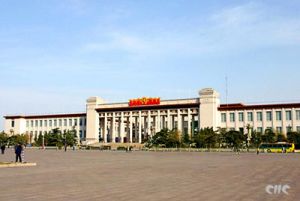The National Museum of China
The National Museum of China, a four-storied main building with two symmetrical wings, runs more than 300 meters north and south along the eastern side of Tian'anmen Square. The predecessors of the National Museum are two museums: the Museum of Chinese History and the Museum of Chinese Revolution, which shared the same building complex.
The building was one of ten famous architectures built in 1959 to mark the 10th anniversary of the founding of the People's Republic. The Museum of Chinese History was in the South Wing while the North Wing housed the Museum of the Chinese Revolution. They were both opened to the public in 1961. The building has a rectangular exterior and faces the Great Hall of the People. Twenty-four square pillars make up the magnificent west gate portico. With its classical color and imposing structure, the whole building is an important part of the panorama of Tian'anmen Square.
The predecessor of the Museum of Chinese History is the Beijing History Museum built in 1912 and was opened to the public in October 1926. In August 1958, the Chinese government decided to establish a new national museum on the eastern side of Tian'anmen Square. The construction was completed in October 1959.
The Museum of Chinese History displays three main periods of Chinese history. The first, the Primitive Society, spans from 500,000BC to 4,000BC. The exhibits in the Slavery Society section cover the time from 2,100BC to 475BC and the Feudal Society exhibits focus on the period from 221BC to 1911. Many of the items on display are national treasures and precious rarities. Examples include the famous fossil remains of Yuanmo Man and Beijing Man, the remarkable painted pottery and jade wares of the Neolithic Age, the Simuwu Rectangle Ding (a kind of vessel) of the Shang Dynasty (cast over 3, 000 years ago and weighing 832. 84kg -- the heaviest ancient bronze ware in the world), the Shang Dynasty square bronze Zun (wine vessel) decorated with four sheep heads and the large inscribed Western Zhou Dynasty (11th century BC - 771BC) bronze Pan (water container). Other exhibits include a gold-inlaid bronze tally in the shape of a tiger (this was used by Emperor Qinshihuang for military affairs), a Han Dynasty (206BC-220AD) jade burial suit sewn with gold thread, magnificent Tri-colored Glazed Pottery of the Tang Dynasty (618-907), world-renowned Song Dynasty (960-1279) ceramics, and a rare bronze human figure marked with acupuncture points. Such treasures as these depict the rich and disparate evolution of the Chinese civilization.Since 1992, about 100 short-term exhibitions have been held in the National Museum of Chinese History. Exhibitors have included both international and domestic organizations, as well as private individuals.
The Museum of the Chinese Revolution emphasizes the history of the past 150 years, in particular the history of the Communist Party of China. It is divided into three sections. The exhibits in the Old Democratic Revolution section cover the period from 1840 to 1911. Events between 1911 and 1949 fall into the New Democratic Revolution section. The third section is entitled "The Triumph of the Revolution and the Establishment of Socialism" and covers events after 1949.Much of China's modern history is exhibited, including the founding of the Chinese Communist Party (1919-1921), the first two civil wars (1924-1927 and 1927-1937), the resistance war against Japanese aggression (1937-1945) and the liberation war (1945-1949). The museum is frequently updated to reflect the developments of modern political history.
Further Information:
Open: 8:30 -- 16:30 (Last Entry at 15:00) for March 1 - June 30
8:00 -- 18:00 (Last Entry at 17:00) for July 1 - August 31
8:30 -- 16:30 (Last Entry at 15:00) for September 1 - October 31
9:00 -- 16:00 (Last Entry at 15:00) for November 1 - February 29
Admission: 30 yuan
Tel: 8610-6512 8901
Website: http://www.nmch.gov.cn
